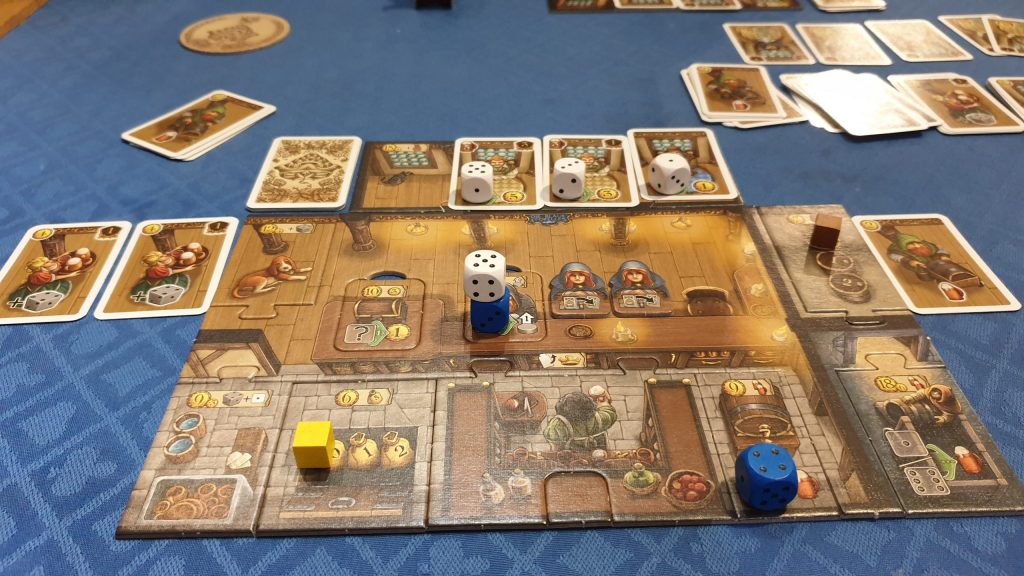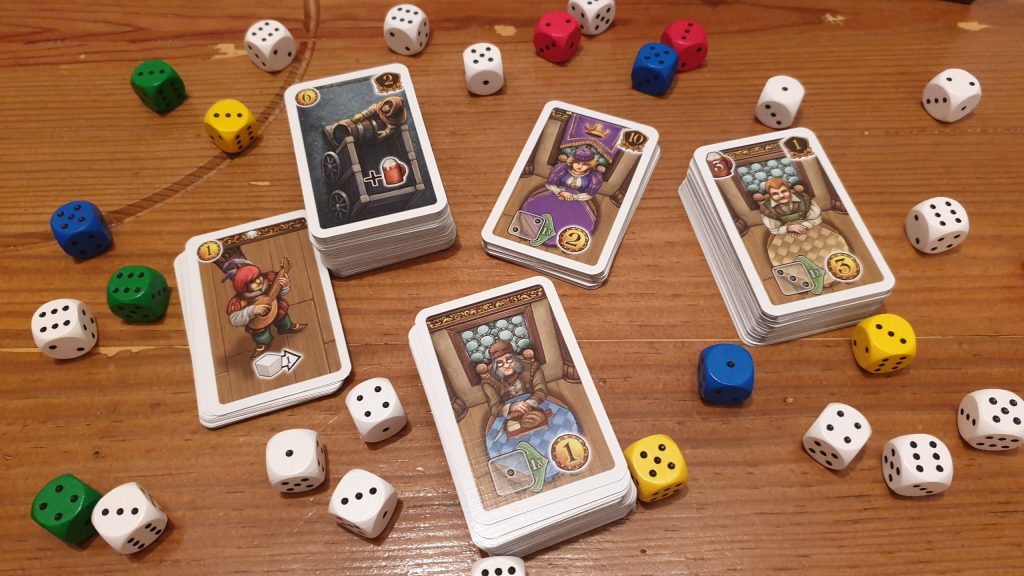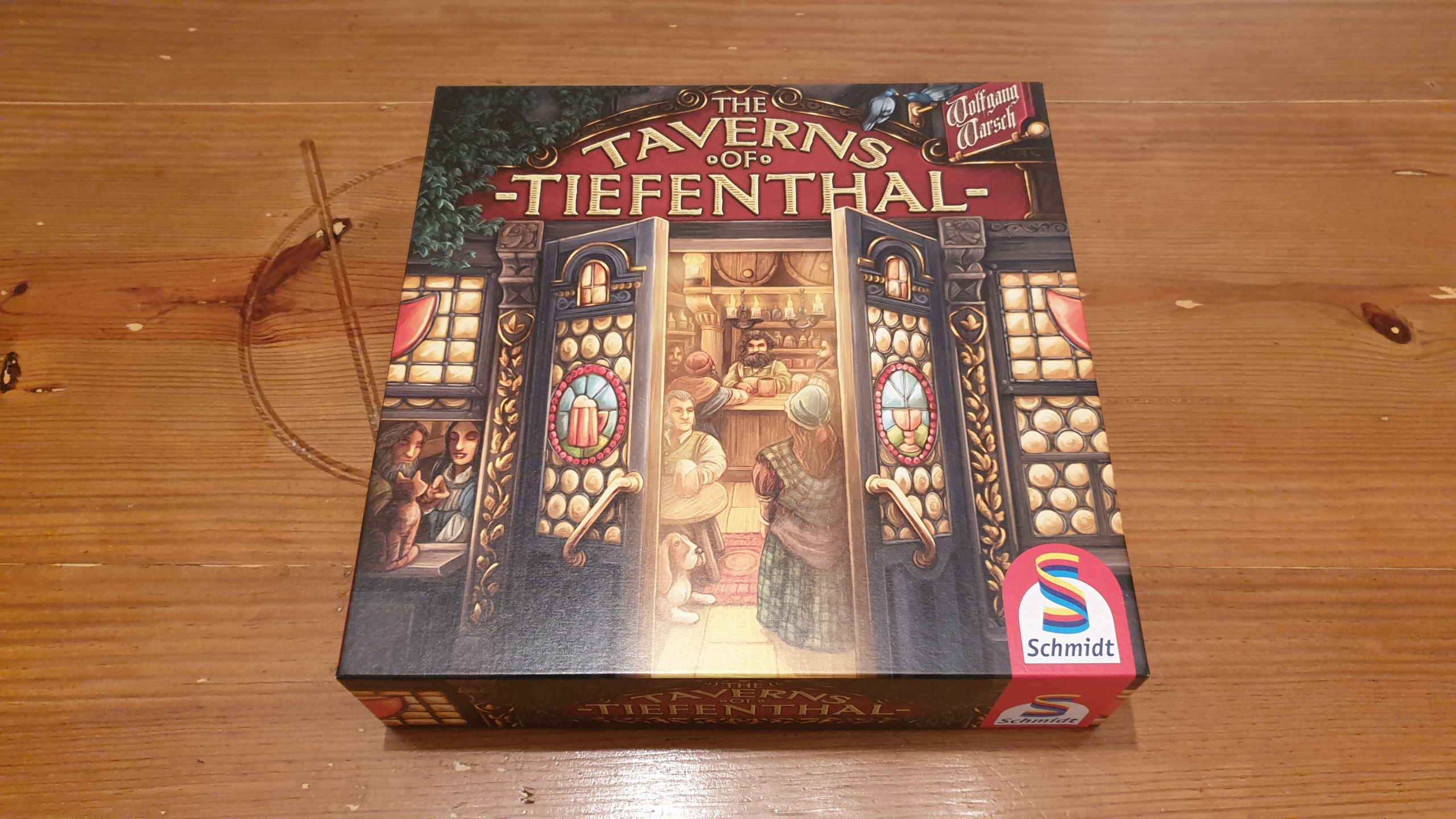The Taverns of Tiefenthal is one of the latest board games from designer Wolfgang Warsch, featuring artwork by Dennis Lohausen. Published by Schmidt Spiele, the game sees 2 – 4 players become tavern owners. Dice will be rolled, decks will be built and hopefully nobles will come to visit – all in around 45 minutes. However, is the world of beer a fun one to dive into? Let’s find out!
The setup of The Taverns of Tiefenthal is rather dependent on whether players are including modules, of which there are four. Regardless, each player will grab a player board, with all associated pieces. They also claim a hand of starting cards and tracker cubes for money and stored beer. The monastery board, with the round and monastery tracks, is placed within sight of all players. A token to denote the round is placed on round 1 and a marker for each player placed on 0 of the monastery track. Players then claim their coloured dice and 4 white dice. Finally, a market of cards is created full of new guests, nobles and tavern cards.
Played over 8 rounds, each round starts with players gaining a bonus. These range from an additional table through to a free waitress. Players then start the round by filling their tavern. Turning over cards from their deck, one at a time, players draw cards until guests completely fill the tables. Alongside guests, players can pull out waitresses to gain additional dice, beer suppliers and more. Once everyone has done this stage it is time to roll dice.
Everyone rolls the 4 white dice in front of them, putting them on a coaster ready to pass around. Each player can also roll their coloured dice at this point – which are their personal dice – with the amount rolled equal to the number of waitresses they have drawn. Players get to take one of the white dice from the coaster in front of them. The rest on the coaster are then passed on to the next player. From the received coaster of white dice another is selected, and so on until all white dice are claimed.

Once players know what dice they have it is time to plan out the evening. For example, guests can be assigned dice with specific values to earn money. Dice can also be used for making beer or advancing up the monastery track, to trigger bonuses. In turn order players activate their dice to determine the amount of money and beer they have to spend.
While money can upgrade elements of the tavern itself it can also be used to purchase tavern cards – to improve your deck of cards with additional tables, waitresses and more. Beer is also spent to acquire cards, though this is for new guest cards and nobles. Unlike regular guests nobles are worth vastly more victory points – plus they all sit at one table instead of separate ones. Regardless of the card type any new cards are added to the top of your deck, with cards used in the round discarded. When drawing cards if your deck runs out all of your discarded cards are shuffled to create a new draw deck.
This continues throughout the 8 rounds with players buying new cards, serving guests, upgrading their tavern, and potentially storing some money or beer from one round to the next. At the end of the game players count up their victory points. A range of tavern cards, acquired guests and nobles come with point values. Whomever has the highest points wins, with ties split by money and beer still in storage.
Described as coming with 5 modules is a little deceiving. Module 1 is actually the base game, so there are truly only 4 modules to add into the mix. The first one is all about schnapps. No longer does your humble pub only deal in beer and money. On top of the usual round income, some now see players acquire schnapps, which is used to pay entertainers. These are effectively bonus actions from gaining 2 coins to getting a free upgrade. While each schnapps is worth 1 victory point they can potentially earn players much more.
The next module is about reputation. It removes the schnapps round income but adds a new track to progress around. The reputation track can provide schnapps, remove bad guests and even attract nobles. This tracker gives players another route to victory, but does realistically require the schnapps module to be worthwhile. Module 4 is a small set of 7 cards. Shaking up the starting setup players decks and taverns are given asymmetrical twists. From removing regular guests from your starting deck through to starting with one aspect of your tavern upgraded, this is ideal for giving players a bump in different directions towards victory. The final module is a guestbook which fills up as new guests come to your tavern. Bonuses, such as a dishwasher, can be earnt from collecting the signatures, all the way up to nobles.

Straight away it is like the game has expansion content. Players can choose whether to use the modules and this generates replayability, as they find out which combination they like best. Most, after a game, will want to keep schnapps included. It gives a new avenue of choice during play, which the base game is crying out for. As a base game, with no modules, it isn’t an experience to keep going back to, so the inclusion of the modules is brilliant at changing that. Some will argue that they should just be the game, and the schnapps content of module 2 probably should be. It certainly adds to the overall experience without making the experience any harder to grasp. The game can be a little easier and quicker to get to the table with inexperienced players without modules though.
One aspect that is an interesting change from most games with deck building is that new cards are added to the top of your deck. Given the short length of the game, only 8 rounds, combined with the limited amount of times your deck is shuffled, it is ideal. Players get the instant impact of a choice to buy something. This creates an extra importance to when you buy what. That new customer or new waitress will come up next round, potentially forcing additional tables or other more useful guests down the pile.
There are two aspects of The Taverns of Tiefenthal that scream luck. The order of cards coming out of your deck is luck based. Then, dice are rolled – often with specific numbers needed. Players do have chances to mitigate the luck. Additional waitresses help by increasing the dice count, while dishwashers allow 1 to be added a die value. However, there is no way to decrease a die value, aside from the rarely usable schnapps ability to change a single die.
In many games featuring this much luck it is all about pushing your own luck. Choosing to keep drawing or turning cards. This choice is out of players hands in The Taverns of Tiefenthal. Once your tables are full you are stuck with the outcome. Thankfully, a Counter Guest token can be discarded to discard all cards drawn that round and redraw. This allows players to have small and then incredible rounds. Perhaps with only 8, the ratio of great feeling rounds is a tad low, but this just makes those big plays feel more special.
Component wise The Taverns of Tiefenthal is good, without being amazing. Take the player boards. These come in many parts, which are on the fiddly side to construct. Once made though they work well to have upgradeable elements that flip without disrupting the rest of the player board. They also create the whole tavern, down to the cellar and a friendly dog, allowing for a visually pleasing layout in front of players. The cards and dice are okay but could be larger in size. Nevertheless, both are clear and easy to read. Having coasters to put the dice on and pass around is certainly a nice touch.
Wolfgang Warsch’s follow on title from The Quacks of Quedlinburg was always going to have quite a spotlight on it. The Taverns of Tiefenthal does feel similar, without having almost anything in common. Gone are bag building and potion ingredients. Instead dice rolling and deck building are what players need to work with. The similarities come from the choices players have, of what to spend on and what to gain. There isn’t the same amount of choice as before – where every ingredient did something unique. There are still enough to make the tavern business one to enjoy – if you don’t mind a slice of luck – regardless of if you can cram a table full of nobles or not!
(Editor’s Note: The Taverns of Tiefenthal was provided to us by Coiledspring Games for the review. Check out the official website for the game here.)

